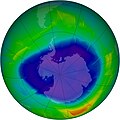Dosiero:2009 Antarctic Ozone Hole (3927062424).jpg
Etoso

Grandeco de ĉi antaŭvido: 600 × 600 rastrumeroj. Aliaj distingivoj: 240 × 240 rastrumeroj | 480 × 480 rastrumeroj | 716 × 716 rastrumeroj.
Bildo en pli alta difino ((716 × 716 rastrumeroj, grandeco de dosiero: 283 KB, MIME-tipo: image/jpeg))
Dosierhistorio
Alklaku iun daton kaj horon por vidi kiel la dosiero tiam aspektis.
| Dato/Horo | Bildeto | Grandecoj | Uzanto | Komento | |
|---|---|---|---|---|---|
| nun | 01:28, 12 maj. 2018 |  | 716 × 716 (283 KB) | OceanAtoll | Transferred from Flickr via #flickr2commons |
Dosiera uzado
Neniu paĝo ligas al ĉi tiu dosiero.
Suma uzado de la dosiero
La jenaj aliaj vikioj utiligas ĉi tiun dosieron:
- Uzado en de.wikibooks.org
- Uzado en en.wikibooks.org
